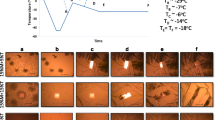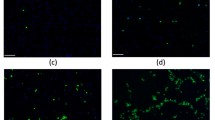Abstract
Purpose
The present study is aimed at understanding how the interactions between sugar molecules and phosphate ions affect the glass transition temperature of their mixtures, and the implications for pharmaceutical formulations.
Methods
The glass transition temperature (T g ) and the α-relaxation temperature (T α ) of dehydrated trehalose/sodium phosphate mixtures (monobasic or dibasic) were determined by differential scanning calorimetry and dynamic mechanical analysis, respectively. Molecular dynamics simulations were also conducted to investigate the microscopic interactions between sugar molecules and phosphate ions. The hydrogen-bonding characteristics and the self-aggregation features of these mixtures were quantified and compared.
Results
Thermal analysis measurements demonstrated that the addition of NaH2PO4 decreased both the glass transition temperature and the α-relaxation temperature of the dehydrated trehalose/NaH2PO4 mixture compared to trehalose alone while both T g and T α were increased by adding Na2HPO4 to pure trehalose. The hydrogen-bonding interactions between trehalose and HPO4 2− were found to be stronger than both the trehalose-trehalose hydrogen bonds and those formed between trehalose and H2PO4 −. The HPO4 2− ions also aggregated into smaller clusters than H2PO4 − ions.
Conclusions
The trehalose/Na2HPO4 mixture yielded a higher T g than pure trehalose because marginally self-aggregated HPO4 2− ions established a strengthened hydrogen-bonding network with trehalose molecules. In contrast H2PO4 − ions served only as plasticizers, resulting in a lower T g of the mixtures than trehalose alone, creating large-sized ionic pockets, weakening interactions, and disrupting the original hydrogen-bonding network amongst trehalose molecules.








Similar content being viewed by others
References
Franks F. Scientific and technological aspects of aqueous glasses. Biophys Chem. 2003;105:251–61.
Levine H. Amorphous food and pharmaceutical systems. Cambridge: Royal Society of Chemistry; 2002.
Elmonsef Omar A, Roos YH. Glass transition and crystallization behaviour of freeze-dried lactose–salt mixtures. LWT Food Sci Technol. 2007;40:536–43.
Reis J, Sitaula R, Bhowmick S. Water activity and glass transition temperatures of disaccharide based buffers for desiccation preservation of biologics. J Biomed Sci Eng. 2009;2:594–605.
Weng L, Vijayaraghavan R, MacFarlane DR, Elliott GD. Application of the Kwei equation to model the Tg behavior of binary blends of sugars and salts. Cryobiology. 2013;68:155–8.
Fujita K, Forsyth M, MacFarlane DR, Reid RW, Elliott GD. Unexpected improvement in stability and utility of cytochrome c by solution in biocompatible ionic liquids. Biotechnol Bioeng. 2006;94:1209–13.
Weaver KD, Kim HJ, Sun J, MacFarlane DR, Elliott GD. Cyto-toxicity and biocompatibility of a family of choline phosphate ionic liquids designed for pharmaceutical applications. Green Chem. 2010;12:507–13.
Ohtake S, Schebor C, Palecek SP, de Pablo JJ. Effect of pH, counter ion, and phosphate concentration on the glass transition temperature of freeze-dried sugar-phosphate mixtures. Pharm Res. 2004;21:1615–21.
Miller DP, Anderson RE, de Pablo JJ. Stabilization of lactate dehydrogenase following freeze-thawing and vacuum-drying in the presence of trehalose and borate. Pharm Res. 1998;15:1215–21.
Van der Sman RG. Predictions of glass transition temperature for hydrogen bonding biomaterials. J Phys Chem B. 2013;117:16303–13.
Van der Sman R, Meinders M. Moisture diffusivity in food materials. Food Chem. 2013;138:1265–74.
Nakanishi M, Nozaki R. Model of the cooperative rearranging region for polyhydric alcohols. Phys Rev E. 2011;84:011503.
Nakanishi M, Nozaki R. Systematic study of the glass transition in polyhydric alcohols. Phys Rev E. 2011;83:051503.
Angell C, Sare J, Sare E. Glass transition temperatures for simple molecular liquids and their binary solutions. J Phys Chem. 1978;82:2622–9.
Taylor LS, Zografi G. Sugar–polymer hydrogen bond interactions in lyophilized amorphous mixtures. J Pharm Sci. 1998;87:1615–21.
Harrison RM, De Mora SJ. Introductory chemistry for the environmental sciences, Cambridge University Press1996.
Sussich F, Cesàro A. Trehalose amorphization and recrystallization. Carbohydr Res. 2008;343:2667–74.
Seo JA, Oh J, Kim HK, Hwang YH, Yang YS, Kim SJ. Study of glass transition temperatures in sugar mixtures. J Korean Phys Soc. 2005;46:606–9.
Phillips JC, Braun R, Wang W, Gumbart J, Tajkhorshid E, Villa E, et al. Scalable molecular dynamics with NAMD. J Comput Chem. 2005;26:1781–802.
Guvench O, Hatcher E, Venable RM, Pastor RW, MacKerell Jr AD. CHARMM additive all-atom force field for glycosidic linkages between hexopyranoses. J Chem Theory Comput. 2009;5:2353–70.
Neria E, Fischer S, Karplus M. Simulation of activation free energies in molecular systems. J Chem Phys. 1996;105:1902.
Yesselman JD, Price DJ, Knight JL, Brooks CL. MATCH: an atom-typing toolset for molecular mechanics force fields. J Comput Chem. 2012;33:189–202.
Caffarena ER, Grigera JR. Hydration of glucose in the rubbery and glassy states studied by molecular dynamics simulation. Carbohydr Res. 1999;315:63–9.
Yoshioka S, Aso Y, Kojima S. Prediction of glass transition temperature of freeze-dried formulations by molecular dynamics simulation. Pharm Res. 2003;20:873–8.
Giovambattista N, Angell CA, Sciortino F, Stanley HE. Glass-transition temperature of water: a simulation study. Phys Rev Lett. 2004;93:047801.
Weng L, Elliott GD. Dynamic and thermodynamic characteristics associated with the glass transition of amorphous trehalose-water mixtures. Phys Chem Chem Phys. 2014;16:11555–65.
Weng L, Chen C, Zuo J, Li W. Molecular dynamics study of effects of temperature and concentration on hydrogen-bond abilities of ethylene glycol and glycerol: implications for cryopreservation. J Phys Chem A. 2011;115:4729–37.
Skarmoutsos I, Guardia E, Samios J. Hydrogen bond, electron donor-acceptor dimer, and residence dynamics in supercritical CO-ethanol mixtures and the effect of hydrogen bonding on single reorientational and translational dynamics: a molecular dynamics simulation study. J Chem Phys. 2010;133:014504.
Wolkers WF, Oldenhof H, Alberda M, Hoekstra FA. A fourier transform infrared microspectroscopy study of sugar glasses: application to anhydrobiotic higher plant cells. Biochim Biophys Acta, Gen Subj. 1998;1379:83–96.
Steiner T. The hydrogen bond in the solid state. Angew Chem Int Ed. 2002;41:48–76.
Crowe LM. Lessons from nature: the role of sugars in anhydrobiosis. Comput Biochem Physiol A Mol Integr Physiol. 2002;131:505–13.
Espinosa E, Molins E, Lecomte C. Hydrogen bond strengths revealed by topological analyses of experimentally observed electron densities. Chem Phys Lett. 1998;285:170–3.
Lodish H, Berk A and Zipursky S. Mol Cell Biol.2000.
Hasegawa M, Noda H. Distribution of hydrogen bond angles in molecular crystals. Nature. 1975;254:212.
Angell C. Liquid fragility and the glass transition in water and aqueous solutions. Chem Rev. 2002;102:2627–50.
Harvey JA, Basak D, Venkataraman D, Auerbach SM. Simulating hydrogen-bond clustering and phase behaviour of imidazole oligomers. Mol Phys. 2012;110:957–66.
Han S, Kumar P, Stanley HE. Hydrogen-bond dynamics of water in a quasi-two-dimensional hydrophobic nanopore slit. Phys Rev E. 2009;79:041202.
ACKNOWLEDGMENTS AND DISCLOSURES
This study was supported by grant #5RO1GM101796 from the National Institutes of Health. DMA and DSC measurements were performed at the Materials Characterization Laboratory (MCL), a user research facility supported in part by the Energy Production and Infrastructure Center (EPIC) at the University of North Carolina at Charlotte.
Author information
Authors and Affiliations
Corresponding author
Rights and permissions
About this article
Cite this article
Weng, L., Elliott, G.D. Distinctly Different Glass Transition Behaviors of Trehalose Mixed with Na2HPO4 or NaH2PO4: Evidence for its Molecular Origin. Pharm Res 32, 2217–2228 (2015). https://doi.org/10.1007/s11095-014-1610-1
Received:
Accepted:
Published:
Issue Date:
DOI: https://doi.org/10.1007/s11095-014-1610-1




